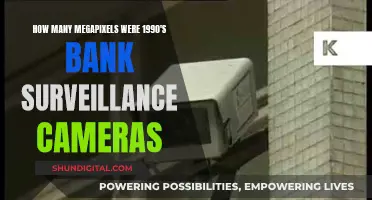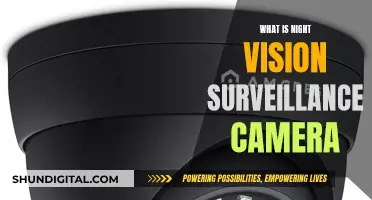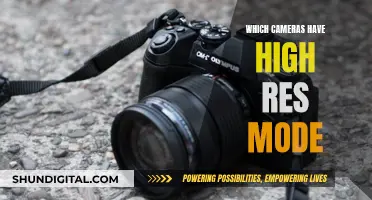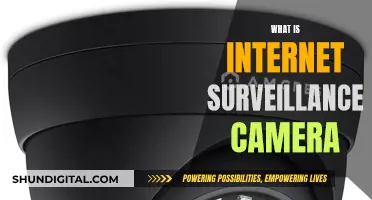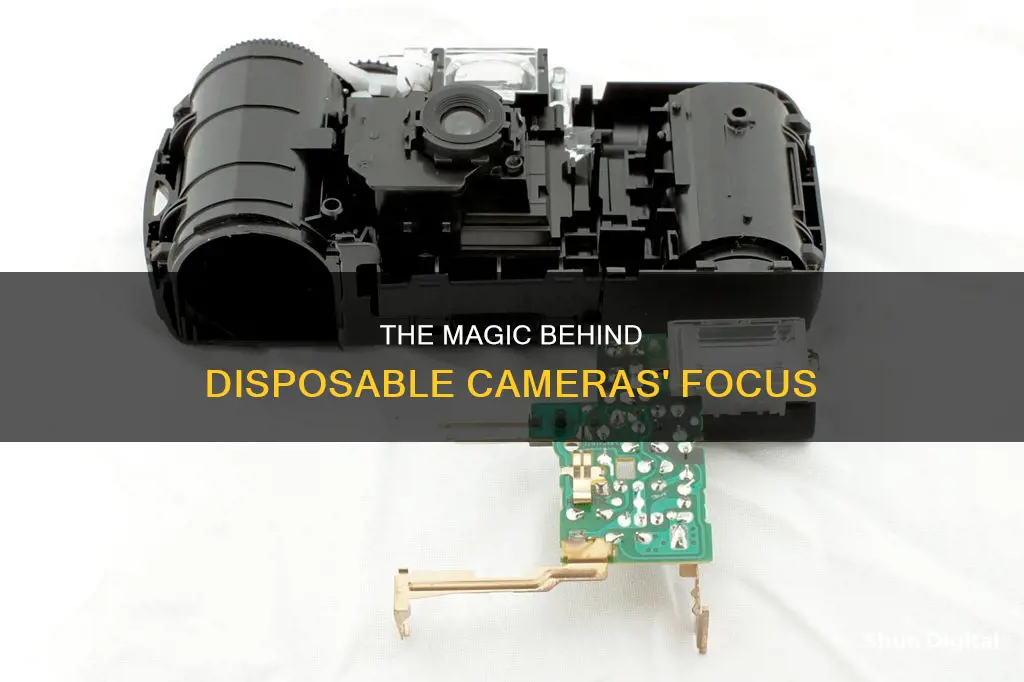
Disposable cameras are designed to be simple, cheap, and lightweight, with no focus or exposure controls. They have a small, fixed aperture and use hyperfocal distance to ensure that everything from around 1 metre to infinity is in acceptable focus. The sharpest part of the image tends to be around 5-10 feet away, in the centre of the frame. Disposable cameras also have a fixed shutter speed, usually around 1/100th of a second, and a fixed focal length, which is why you can't get very close to your subject.
| Characteristics | Values |
|---|---|
| Focus | Fixed |
| Focus Range | 4ft to infinity |
| Aperture | Small and fixed |
| Hyperfocal Distance | Everything from 1m to infinity is in acceptable focus |
| Focal Length | 24 to 35mm |
| Shutter Speed | Slow |
What You'll Learn

Fixed focus lenses have a set range of sharp focus
Fixed-focus lenses have a set range of sharp focus, or depth of field, which is determined during the design or manufacturing phase. This means that the focus cannot be adjusted by the user. The focus is typically set to the hyperfocal distance, which ensures that objects within a certain range—usually from around 2.4 to 10 feet away—appear sharp in the final image. This range is acceptable for most cameras used to capture images of humans or objects larger than a meter.
Disposable cameras, which often use fixed-focus lenses, are designed to be used without any focus control by the photographer. This means that the subject of the photograph should be within the set range of sharp focus for the lens, typically between 5 and 10 feet away, in order to be in focus. Outside of this range, images may appear blurry.
The depth of field of a fixed-focus lens can be increased by reducing the aperture size. A smaller aperture also results in less light reaching the film or sensor, which can make these lenses unsuitable for capturing fast-moving objects or low-light scenes. However, a wider angle of view can compensate for this by allowing more light to enter the lens.
Fixed-focus lenses are commonly used in applications where objects are consistently presented at a set distance from the camera, such as in industrial quality control checks or medical skin examinations. They are also advantageous when fast image capture is required without any interruptions, such as in outdoor kiosks for capturing document details.
Camera Battery Swap: Is It Safe?
You may want to see also

Subjects should be 4-10 feet away for best results
When taking a photo, the distance between the camera and the subject is an important factor in achieving the desired shot. Disposable cameras, with their fixed focus lenses, have a sweet spot for the sharpest images, which is typically between 4 and 10 feet away from the subject. This range ensures that the pictures are clear and in focus.
The concept of "hyperfocal distance" is key to understanding how disposable cameras can focus effectively from 1 metre to infinity. By utilising a wide-angle lens with a narrow aperture, disposable cameras are able to maintain acceptable focus across a wide range of distances. This setup results in a large depth of field, allowing objects from 1 metre to infinity to appear reasonably sharp.
The distance from the camera to the subject also plays a crucial role in determining the depth of field. The closer the camera is to the subject, the shallower the depth of field becomes relative to the chosen aperture setting. For example, when using a 50mm lens at an f/1.8 aperture, the depth of field at 2 feet will be significantly shallower than at 10 feet. At 4 feet, the depth of field is approximately 1.5 inches, while it increases to almost 10 inches at 10 feet.
Additionally, the fixed focus nature of disposable cameras makes them more suitable for capturing up-close and personal photos rather than large, scenic landscape shots. It is important to keep the subject within the specified range of 4 to 10 feet to ensure they remain in focus.
By following these guidelines and understanding the relationship between distance and depth of field, photographers can effectively utilise disposable cameras to capture memorable moments with clear and focused images.
Tasco Trail Camera: Loading Batteries for Optimum Performance
You may want to see also

Hyperfocal distance ensures everything from 1m to infinity is in acceptable focus
Disposable cameras are able to focus on objects from 1m to infinity by using the hyperfocal distance. This is a distance from the lens beyond which all objects can be brought into an "acceptable" focus. The hyperfocal distance is the focus distance that gives the maximum depth of field, and so it is the most desirable distance to set the focus of a fixed-focus camera.
The hyperfocal distance is dependent on what level of sharpness is considered acceptable. The criterion for the desired acceptable sharpness is specified through the circle of confusion (CoC) diameter limit, which is the largest acceptable spot size diameter that an infinitesimal point is allowed to spread out to on the imaging medium (film, digital sensor, etc.). The hyperfocal distance is calculated using the focal length of the lens, the f-number (f/D for aperture diameter D), and the CoC.
The hyperfocal distance has a property called consecutive depths of field, where a lens focused at an object at the hyperfocal distance will hold a depth of field from H/2 to infinity. If the lens is focused at H/2, the depth of field will be from H/3 to H, and so on.
Some cameras have their hyperfocal distance marked on the focus dial. For example, the Minox LX focusing dial has a red dot between 2m and infinity. When the lens is set to this, the depth of field stretches from 2m to infinity.
The hyperfocal distance is particularly useful in landscape photography, as it helps to make the most of the depth of field, producing a more detailed final print. However, it is important to note that the hyperfocal distance may not be appropriate for photos that require quick judgment or have a limited depth of field.
Bosch Cameras: Where Are They Manufactured?
You may want to see also

Wide-angle lenses with small apertures increase depth of field
Disposable cameras are able to focus from 1 metre to infinity, without an autofocus mechanism, by using the hyperfocal distance. This is achieved through a combination of a wide-angle lens and a small aperture.
A wide-angle lens has a focal length of 35mm or shorter, which gives the lens a wide field of view. The shorter the focal length, the wider the field of view and the more of the scene that will be captured in the frame. Wide-angle lenses are popular with landscape photographers as they are able to capture sweeping vistas and starry nights. They are also used for architecture and real estate photography, as they make spaces feel more expansive and impressive.
The aperture is a hole in the lens that can vary in size to control the amount of light entering the camera. When the aperture is set to a very open position, lots of light enters the camera and the resulting image will have a shallow depth of field. Closing the aperture to a small setting diminishes the amount of light entering the camera, but it also results in a greater depth of field. The narrow aperture results in more depth of field because the light that is forced through the small opening results in objects being more in focus, even if the lens isn't properly focused on the subject.
A wide-angle lens with a small aperture increases the depth of field because the wide-angle lens allows for a large depth of field, and the small aperture setting further increases the depth of field. Therefore, a wide-angle lens with a small aperture will result in a very large depth of field, bringing objects in the foreground and background into focus.
Xomodo Wireless Cameras: How Long Does the Charge Last?
You may want to see also

Disposable cameras are poor in low-light conditions
Disposable cameras are known for their convenience and ease of use. However, they have limitations when it comes to low-light conditions, which can result in poor-quality images. Here are some reasons why disposable cameras struggle in low-light settings:
- Fixed Aperture and Shutter Speed: Disposable cameras typically have a fixed aperture and shutter speed, which means you cannot adjust these settings to let in more light. As a result, they may not capture enough light to produce well-exposed images in low-light environments.
- High ISO Film: Most disposable cameras use ISO 400 film, which is less sensitive to light compared to higher ISO films. While higher ISO films can capture better images in low light, they tend to produce grainier pictures.
- Limited Flash Range: The built-in flash on disposable cameras has a limited range, typically effective only within 4 to 10 feet of the camera. Beyond this range, the flash may not provide sufficient illumination, leading to dark and underexposed photos.
- Slow Shutter Speed: Disposable cameras often have a slow shutter speed, which can result in blurry images if the camera or subjects are in motion. In low-light conditions, the slow shutter speed can further exacerbate the problem of motion blur.
- Lack of Exposure Controls: Disposable cameras generally lack exposure controls, which means you cannot manually adjust settings to compensate for low-light conditions. This lack of control can make it challenging to capture well-lit images in dark environments.
To improve the performance of disposable cameras in low-light settings, it is recommended to use the flash whenever possible and ensure that subjects are within the effective flash range. Additionally, shooting in bright, well-lit environments can help improve image quality. However, due to their inherent limitations, disposable cameras may still struggle to produce high-quality images in low-light conditions.
Is Your ADT Doorbell Camera Charging?
You may want to see also
Frequently asked questions
Disposable cameras have a fixed focus lens, which means they have a set range at which they can capture clear pictures. This range is usually between 4 to 10 feet away from the camera.
The sharpest part of your disposable shot is typically within a range of 5 to 10 feet, so it's best to keep your subject within this "sweet spot" for the clearest results.
Disposable cameras use the concept of hyperfocal distance to ensure that everything from a certain distance to infinity appears in acceptable focus. This is achieved by combining a wide-angle lens with a small aperture.


